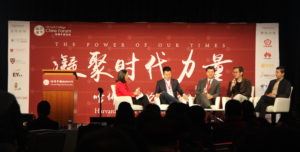With a cup of hot coffee held securely in one hand and a large laminated name tag dangling from the other, we trekked through the “Boulevard of Flags” in Boston’s World Trade Center as the morning sun peeked through the surrounding skyscrapers. It was April 7, 2018, and we were headed to the opening ceremony of the Harvard College China Forum’s annual conference. Since 1997, the HCCF has run the largest student-led conference in North America, bringing in speakers from around the world to discuss topics from international relations to finance to environmental policy.
The conference was an exhilarating whirlwind of dialogue. Corporate executives and politicians milled around in polished business attire, cameras clicked and flashed to capture every insightful moment, and speeches were given equally in both English and Chinese–a somewhat jarring experience for your humble correspondents who are not quite as proficient in Chinese as they would like.
This year, one theme threaded through almost every conversation at the conference: China’s meteoric rise in the global economy, especially within the field of technological production. Domestic Chinese technology companies are driving this growth, with 30.3% of Chinese GDP or $3.35 trillion held by technology giants Baidu, Alibaba, and Tencent. That number is expected to reach $16 trillion by 2035.
Yet, technology and entrepreneurship are not synonymous with innovation. China has a reputation for imitation rather than innovation, and has been criticized for making counterfeits and cheap knock-offs of international technology products. But China cannot become a global superpower without inventing its own path. As Richard Cooper, professor of international economics at Harvard University, commented at the HCCF opening ceremony, “I’m still waiting for the first breakthrough innovation from China.” As China strives to become a prominent leader in the global economy, will its technological rise also portend a revolution in innovation?
Fast-Forward
While Westerners like Professor Cooper might doubt China’s capacity to innovate, tech leaders from Beijing point to a track record of success. Supportive government policies are channeling millions of dollars into areas like Shenzhen, a former manufacturing city now known as the Silicon Valley of China. By incentivizing property holdings for new startups and tech ventures, the government has been working hard to cultivate a center of Chinese technological innovation. These policies have been paying off. Major Chinese multinational firms like Huawei and Tencent dominate this city, while smaller ventures tie into a network of support from venture capitalists, incubators, and local manufacturing companies.
Like Silicon Valley, the success of Shenzhen has become a model for other regions looking to spur growth in new sectors. Beijing, Shanghai and Chengdu are among the 17 national innovation zones following Shenzhen’s lead. Across China, government incentives are accelerating the growth of a new entrepreneurial class. When asked about the potential for future innovation in China–a Huawei representative answered somewhat dismissively that “China is already an innovation leader.” When it comes to Chinese entrepreneurial success, it appears only foreigners are questioning the country’s potential.
This year’s HCCF coincided with the 40th anniversary of gǎigé kāifàng, or the “reform and opening-up” of the Chinese economy. Bolstered by the country’s meteoric ascent during these past decades, party leadership and private workers alike are committed to ensuring future growth. Today, China is pursuing a bold transformation of its the tech sector, with ambitious government-led goals such as becoming the world’s AI leader by 2030. Despite a significant roster of achievements under China’s belt, Fred Hu from Primavera Capital captured the ambitions of the country when he downplayed the present as only “a very promising beginning.”
Startup Culture
Walk through any convenience store in the United States today, and the majority of products will likely have “Made in China” inscribed in tiny letters on the packaging. As China grows, so too will the presence of these three ubiquitous words. That is the basis of “Made in China 2025,” an ambitious plan rolled out by the Chinese government in 2015 to encourage high-tech development, aim for technological “self-sufficiency”, and change the connotation of Chinese products being cheap and low-quality over the next decade. For China, it is not enough to simply be a competitor; it must be the global leader in all things tech.
China has a few distinct advantages for tech-based startups. Joy Tan, president of Global Media and Communications at Huawei Technologies, told the crowd at HCCF that technology companies are in the midst of “an intelligence revolution.” According to Tan, the companies and countries with the greatest access to data will be able to develop the best intelligent devices, utilizing machine learning and artificial intelligence driving by data mining. Boasting the largest population in the world, China offers its companies unique access to the countless data points of over 600 million smartphone users.

Boulevard of Flags, Harvard College China Forum, 2018.
In addition to data, China’s large consumer base allows Chinese companies to grow and compete with one another at an accelerated rate. Arthur Zhang, managing director at ZhenFund, China’s largest angel investment fund, stated at the HCCF’s Venture Capital panel that the reason Chinese companies like WeChat are so large and ubiquitous when compared to American companies is because, according to an old proverb, shuǐdà yúdà–that is, Chinese companies benefit from being “Big Fish in a Big Pond.” The rise of Chinese ‘unicorns,’ or private companies valued at 1 billion or more, is one marker of the country’s potential growth. As of 2014, half of the world’s most valuable ‘unicorns’ originated in China. Finally, because services like Facebook, Google, and Twitter are blocked in China, domestic firms enjoy more room to grow and experiment compared to most international companies.
The rapid success of these ventures shows how quickly China has managed to capitalize on its innovation-driven policy goals. However, the West has questioned whether or not Chinese firms are truly entrepreneurial, labeling internet giants like Baidu, Alibaba, and Xiaomi ‘copycats’ of Google, eBay, and Apple, respectively. Today, the tide is turning. Last year, Connie Chan of the venture capital firm Andreessen Horowitz argued that not only are Chinese firms becoming more unique and independent, U.S. companies are now beginning to imitate Chinese ideas–rather than the other way around.
Didi Chuxing, one of the most promising companies in this group, is illustrative of innovation in China. Known as China’s “Uber”, the comparison fails to encapsulate the nuances of Didi’s platform. More than just a ridesharing company, Didi’s focus on AI has allowed the company to help streamline Chinese infrastructure and navigation in order to tackle traffic gridlock. While the company might seem similar to a U.S. ride-sharing brand, Didi’s new take on the transportation issue in China has shifted its purpose towards a fundamentally different, innovative direction. Similar ridesharing ideas spawned in China have migrated to the United States–for example, Didi has pushed Uber to invest more in self-driving cars, and bike-sharing apps first introduced in China have inspired American counterparts.
The evolution of Tencent’s WeChat, often disparagingly compared to Facebook’s “Whatsapp,” is another example of an East-West generalization that has neglected to appreciate the original contributions of a Chinese product. WeChat is not only a texting platform, but is also a wallet, news source, gaming app, and person-to-person payment system. Now, Whatsapp is following in the footsteps of WeChat, pushing forward initiatives such as ‘verified profiles’ that improve legitimacy and networking for their users.
The narrative of Chinese “copycats” fails to tell the story of these new ventures. Chinese companies are not just copying American models, but they are building their own tools for the 21st century. While these products may appear similar to U.S. brands on the surface, their features show next level innovations in technology. At the HCCF, representatives from China-based companies like Huawei and Sogou pointed out this distinction, while American commentators such as Richard Cooper voiced their skepticism.
An Ocean Apart
For three days in April, the Harvard College China Forum reflected both the historical trends and future aspirations of China’s economy. Jostling to get a seat for panels that featured China’s business elite, the conference was charged with the vitality of young people eager for success. As the conference events oscillated between English and Mandarin, it seemed that two different programs were being held. In English, the dialogue circulated about the potential for Chinese innovation. In Mandarin, the conversation presupposed that innovation was already changing the face of China’s economy.
Sometimes talking past one another, sometimes speaking together, the different attitudes of Western and Eastern panelists seemed to hint at the challenges facing the United States and China as the two economic powers move forward. The Western sense of propriety over entrepreneurship and inability to recognize Chinese innovation was countered with Chinese frustrations about how “Westerners don’t understand our China.” In light of the looming trade war between these two countries, these mutually dismissive attitudes are troubling. In the near future, the United States and China will need to learn to collaborate in order to bring about global change.
While it may seem like Chinese and American interests are separate, that is not the case. Increasingly, the two nations are being put into close quarters. As Harvard Professor, William Kirby, put it succinctly: “Some would say we are sleeping in different beds, dreaming the same dreams. This is simply not true. We are in bed together.” Dialogues like the Harvard College China Forum are crucial to helping China and the United States understand that their shared imagination and ambition outweigh their competitive differences.
Image Credit: Harvard Political Review/Alicia Zhang
